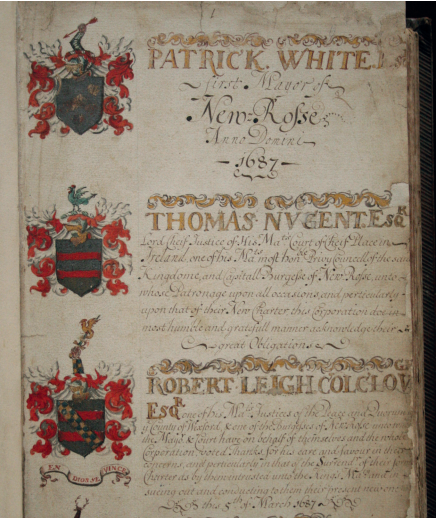Shining a light on early town governance in New Ross
Published in Issue 1 (January/February 2020), News, Volume 28Enhancing user access to the town’s oldest municipal minutes.
By Gráinne Doran and Linda Doran

Above: An illustrated page from a 1687 list of New Ross’s mayor and officials. (Wexford County Archive)
Wexford County Archive is the official repository for the archives and records of local government in County Wexford, in addition to an extensive range of archival collections of private origin. The archive facilitates academic, local and family history research in its reading room.
In recent years, digital technologies have transformed how archives are accessed and used by the public. The traditional means of viewing archival material in the reading room has now been superseded by on-line access. In response to this, Wexford County Archive, as part of its annual digitisation programme, has prioritised the digital capture of its more popularly used holdings and has made them available on-line in an effort to enhance remote access.
Digitisation of archives works best when the materials are typescript, printed or at least written in a legible hand. Challenges can arise, however, when manuscript materials from the Tudor and Stuart periods are digitised and made available on-line in their original form.
Representing the earliest extant municipal archives in County Wexford, the first two minute books of New Ross Corporation (1658–1732) provide a unique insight into the functioning of local government of the period, in addition to land and property management and a glimpse of the characters and personalities who populated the town. The two volumes were digitised in 2016 but a decision was taken not to make them available on-line immediately, as they are written in Secretary hand, a style of handwriting that can present a significant challenge to decipher for the majority of potential users. Making them available on-line would only have appealed to a select few, mainly academics. One of the objectives of Wexford County Archive is to enhance access remotely but in a format that will be fully accessible to all end users. It was therefore decided to undertake a transcription project in the summer of 2017.
Each transcribed page has now been digitally stitched to its digitised counterpart and all transcriptions are fully searchable, thus making them available to all our user groups. The project has been made available on Wexford County Archive’s new website following a launch in New Ross in December 2019.
A single surviving fragment from the New Ross Corporation Minute Books for 1634–5 is held in Carlow Library and offers an interesting insight into local governance in seventeenth-century Ireland. This was a century of almost continual unrest, beginning with the Flight of the Earls and ending with the battles of the Boyne and Aughrim. Among the issues highlighted in the minutes is the cost, both financial and social, of defence for a small but strategically important town. The billeting of troops—how this was to be organised, who was to be exempted, the stabling of horses—takes up weeks of discussion. The payment for the damage caused by the troops and the cost of the care of those wounded were also of concern. There was clearly substantial resistance to the billeting of troops and a resentment of the disruption. The heads of households were required to arm themselves and freemen were appointed to acquire arms in the countryside. Sentry-boxes were installed on the quay and at the market.
Conditions for the granting of the freedom of the town provide a wonderful glimpse into the priorities of the authorities. Service in the militia was important and particular trades were encouraged—button-makers, apothecaries and shoemakers were made freeman. Sons of freemen and the husbands of daughters of freemen were also granted the privilege. The religious divisions of the period can be seen in the fact that both Roman Catholics and Quakers are sworn without the oath. The religious and political tensions are illustrated by the stipulation that the Folly House, a property close to the Market Gate of the town and therefore a strategic location, was not to be rented to Catholics. Instead, it was rented to a scholar to teach ‘poor boys of the town’.
Most of the entries, however, concern day-to-day life—keeping the streets clean, securing the water supply, renting out property, protecting the markets and keeping citizens safe. Repair of the conduit in ‘a manner to prevent the lead being stolen’, the gate closing times, when the bakehouses may be heated (not at night) and the control of ‘hucksters’ at the market—these were the affairs of greatest concern. The books show the efforts of the council to protect the citizens and ensure the smooth running of affairs at a time when their town was caught in the tailwinds of international matters.
Gráinne Doran is Wexford County Council Archivist; Linda Doran is editor of New Ross in the RIA’s Irish Historic Towns Atlas series.


















